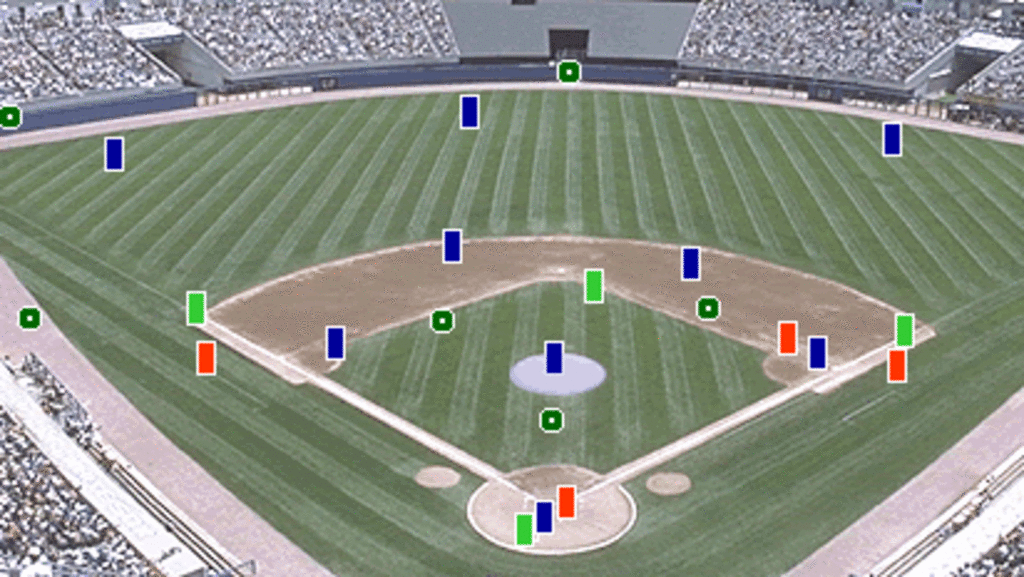Blog
Essential Baseball Rules for Beginners
Understanding the Essential Baseball Rules for Beginners is crucial for anyone looking to enjoy and appreciate this beloved sport. Whether you are a player or a spectator, grasping the fundamental rules will enhance your experience and engagement with the game. In this article, we will explore various aspects of the game, from the overarching rules that govern play to specifics about scoring and player behavior.
>>>Buy now: Unisex Jersey Shirt for Men Women

Basic Structure of the Game
Before diving into the intricacies of baseball, it’s essential to understand the basic structure of the game.
Baseball is played between two teams, each consisting of nine players. The game is typically divided into nine innings, where each team takes turns batting and fielding. Each half-inning ends when the batting team accumulates three outs.
The objective of baseball is straightforward: score more runs than the opposing team by hitting the ball and running around bases in a counterclockwise direction.
Understanding Innings and Outs
In any baseball game, innings dictate how the game progresses. Each inning consists of two halves: the top half, where the visiting team bats, and the bottom half, where the home team takes its turn.
Outs are pivotal to the game’s flow. A team must record three outs before they can switch roles with the opposing team. Outs may be achieved in various ways, including strikeouts, groundouts, and flyouts, each demonstrating different facets of the game.
As players begin to understand these concepts, they will realize how critical each out is to their team’s success. The thrill of a close play, whether it results in an out or a safe call, adds a layer of excitement to every game.
The Role of the Pitcher and Batter
The pitcher holds considerable responsibility during the game. Positioned on the mound, the pitcher aims to deliver the ball to the batter in a way that either strikes them out or induces weak contact. They are strategic players who analyze the strengths and weaknesses of opposing batters, utilizing various pitches like fastballs, curves, and sliders.
On the other side, the batter has the primary goal of hitting the ball effectively to reach base or score runs. Batters must also be disciplined, knowing when to swing and when to let a pitch pass. This dynamic interplay between pitcher and batter is central to the strategic nature of baseball, making it a cerebral sport as much as it is physical.
Scoring Runs in Baseball
Scoring is the heart of any competitive game, and baseball is no exception. Learning how runs are scored is one of the Essential Baseball Rules for Beginners that will greatly enhance a newcomer’s appreciation for the sport.
A run is scored when a player successfully advances around all four bases and touches home plate. This seemingly simple act encompasses a multitude of strategies, teamwork, and skill development.
The Importance of Bases
Bases are integral to how runs are scored. There are four bases: first, second, third, and home plate. When a batter hits the ball, they sprint to first base, aiming to reach safely. If they make it without being tagged out or thrown out, they proceed to the subsequent bases.
Understanding the importance of each base can change how players approach the game. Rushing through bases can lead to costly outs, while playing smart—taking calculated risks and understanding pitcher movements—can create opportunities for scoring.
Different Ways to Score Runs
While hitting the ball is the most common way to score, there are several other methods that players can utilize. Sacrifice flies, walks, and passed balls all contribute to run-scoring opportunities.
For instance, a sacrifice fly occurs when a batter hits the ball deep into the outfield, allowing a runner on base to advance and score while the batter is tagged out. Meanwhile, walks can set up advantageous situations, putting runners on base without risking an out.
This variety of scoring methods showcases the complexity of baseball strategy. Players learn not just to hit but to think proactively, analyzing the game situation and adjusting their tactics accordingly.
Teamwork and Communication on the Field
Scoring isn’t just an individual effort; it requires smooth communication and teamwork among players. In baseball, the “playbook” evolves in real time, and about every decision can impact the outcome of the inning.
Effective communication signals can help players coordinate plays. For example, when a player on base decides to steal, signaling it to the batter increases chances of success. Similarly, fielders must communicate to avoid collisions and ensure successful catches.
Understanding teamwork in scoring situations is another key aspect of the Essential Baseball Rules for Beginners. The beauty of baseball shines through when players work harmoniously towards a common goal, increasing both their chances of winning and enriching the overall spectator experience.
Player Behavior and Sportsmanship
Sportsmanship is crucial to maintaining the integrity of baseball’s spirit. As players engage in competition, understanding proper conduct and behaviors sets the foundation for respect and camaraderie.
Respecting the Opponent and Officials
One of the cornerstone principles of sportsmanship is respecting the opponent. Baseball embodies a culture of respect—from the way players address umpires to how they interact with rival teams.
Respecting umpires, regardless of their decisions, is vital for fostering a positive environment on the field. Disputes can arise, yet it’s important to handle them maturely rather than resorting to negative actions. Ultimately, a player’s response to a tough call defines their character far more than the call itself.
The Role of Bench Etiquette
The bench, or dugout, serves as the nerve center for a baseball team. Player behavior here reflects commitment to teamwork and support. Encouraging teammates, celebrating achievements, and providing constructive feedback are all hallmark traits of a strong team culture.
It’s also imperative to choose words wisely on the bench. Negative comments can demoralize, while uplifting encouragement fosters camaraderie among players. This element of bench etiquette contributes significantly to a team’s morale and performance throughout the game.
Consequences of Unsportsmanlike Conduct
Unsportsmanlike behavior can tarnish the reputation of players and the sport. Actions such as taunting opponents, arguing with officials, or engaging in fights reflect poorly on the entire team and community.
Baseball emphasizes accountability. Players must learn to manage their emotions, channeling passion into performance rather than hostility. Those who demonstrate sportsmanship often find themselves earning respect from fans and players alike, influencing the culture of the sport positively.
Equipment and Playing Field Basics
Understanding the necessary equipment and layout of a baseball field is an important part of grasping the Essential Baseball Rules for Beginners.
Baseball is unique in that it requires specific gear for both players and the field itself. Familiarity with these elements lays the groundwork for effective participation in the game.
Key Equipment for Players
Players require various pieces of equipment to compete effectively. Bats, gloves, helmets, and cleats are standard items, each serving a specific purpose.
The bat must be lightweight yet durable, designed to withstand powerful swings and make solid contact with the ball. Gloves come in various sizes and styles, tailored to the position a player occupies on the field. Helmets protect batters and base runners, ensuring safety from errant pitches or throws. Lastly, cleats provide traction and stability, facilitating quick movements on the diamond.
>>>Read more: How to Improve Batting Skills in Baseball?
Layout of the Baseball Field
The baseball field is uniquely structured, which influences gameplay significantly. It typically consists of an infield and outfield, bounded by foul lines.
The infield includes bases arranged in a diamond shape, with the pitcher’s mound situated at the center. The outfield stretches beyond the infield, creating additional opportunities for hits and catches. Learning the layout of the field allows newcomers to appreciate positional strategies and the physical demands placed on players in different areas.
The Importance of Good Sports Equipment
Quality equipment can greatly influence a player’s performance. Investing in appropriate gear tailored to one’s skills and positions ensures both safety and efficiency on the field.
When players use well-maintained equipment, they can focus on honing their skills rather than worrying about unreliable gear. This proactive attitude toward equipment not only enhances performance but also encourages a mindset focused on improvement and dedication to the sport.
FAQs
What are the rules regarding strikes and balls?
Strikes are recorded when a batter swings at a pitch and misses, or when they don’t swing at a pitch within the strike zone. Balls are called when a pitch is outside the strike zone, and the batter does not swing. After four balls, the batter gets to walk to first base.
How does a player get out?
A player can be out in various ways. Common methods include striking out (three strikes), getting tagged out while running the bases, or being caught out after hitting a fly ball that’s caught by a fielder.
Can a game end in a tie?
In regular season play, baseball games can end in ties if there are local rules about it, but usually, ties are resolved through extra innings until one team wins.
What is the significance of the designated hitter rule?
The designated hitter (DH) rule allows teams to substitute another player to bat in place of the pitcher. This can add strategic depth to games, as teams can strengthen their batting lineup while preserving pitchers’ stamina.
What happens if a ball is hit out of bounds?
When a ball is hit out of bounds, it is considered a foul ball. If a batter hits two foul balls with two strikes already against them, they are out. Foul balls do not count against the batter unless they exceed the limit of strikes.
Conclusion
Grasping the Essential Baseball Rules for Beginners provides a solid foundation for enjoyment and understanding of this captivating sport. From the structure of the game to scoring intricacies, player behavior, and equipment fundamentals, each element weaves together to create a rich experience for players and fans alike.
By immersing oneself in these rules, participants foster a deeper connection to the game, enhancing their appreciation for its nuances. Whether you’re stepping onto the diamond for the first time or sitting in the stands, a well-rounded knowledge of baseball’s rules enriches the experience, transforming casual observers into passionate enthusiasts.


